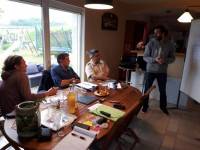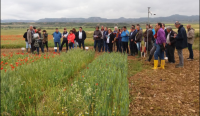A demand-driven co-design strategy
Transition towards increased use of species mixtures entails multiple coordinated and uncoordinated changes in user practices, infrastructure, cultural discourses, markets, policy and governing institutions. Several actors and social groups can be involved (e.g. researchers, farmers, suppliers, processing companies, policymakers, consumers, and social movements) and their actions can change specific system elements (e.g. visions about a more sustainable future, building new technical capabilities, modes of cooperation, economic investments and market shares). The aim of Work Package 1 (WP1) is to understand the measures at the food chain level required to increase the use of species mixtures as a means to ensure they become everyday farming practices. WP1 also aims at understanding the changes required by the socioeconomic sphere (i.e. if the cooperative accepts to collect a mixture, …) in addition to the farming system.The developments made in the project will gradually improve or replace current practices (the dominant regime), which will lead to the improvement of the agricultural system.
WP1 will use on-farm demonstration trials and surveys to identify local practical knowledge on species mixtures and will put in place participatory methodologies involving the agri-food chain actors in order to test and develop novel strategies.
It will also provide a socio-technical analysis of the dynamics of transition pathways and the social-technical levers and lock-ins enabling or blocking the use of species mixtures in EU cropping systems, including regulatory enablers and disablers. Through collective design strategies involving downstream actors, the aim is to provide solutions to overcome these lock-ins going beyond the farming system level.
ReMIX and the EIP-Agri multi-actor approach
The EIP-Agri multi-actor approach involves the close collaboration of end-users and multipliers of research results - farmers and farmers’ groups, advisers, enterprises and others - throughout the whole research project period (https://ec.europa.eu/eip/agriculture/en/about/multi-actor-projects-scientists-and-farmers). ReMIX has embraced this approach, setting up 11 multi-actor platforms (MAPs) in France, Denmark, Greece, Germany, Netherlands, Poland, Spain, Sweden, Switzerland and the UK (https://www.remix-intercrops.eu/The-Project/ReMIX-multi-actor-Platforms). ReMIX will actively involve local stakeholders in these MAPs, gathering actors across the agricultural innovation chain: practitioners, research organisations, advisory and extension services, cooperatives, equipment suppliers, EIP-Agri Operational Groups, policy makers, local and regional public authorities, etc.
Activities in MAPs will span from the specification of end-user needs and the co-design of in-field and on-farm experiments to demonstrations with evaluation of new varieties and practices.
The specific local MAPs differ in objectives and format in the following eleven aspects:
- focus on reliable yields with lower inputs improving soil health and structure;
- organic legumes in mixtures with wheat to increase wheat protein;
- improved plant nutrient utilisation, self-sufficiency in protein feed and increased crop diversity;
- reintroduction of strong traditional cereal-legume practices;
- level of local knowledge and choices for introducing different potential mixtures;
- breeding and wheat-pea mixtures using different cultivars;
- higher legume yield stability while reducing inputs and maintaining outputs;
- spread species mixtures among farmers to identify additional strategies and logistics that needs improvements;
- grain species mixtures to reduce cost, including both harvest strategies and potential following sorting;
- diversified catch cropping mixtures as a starting point moving towards other potential mixtures along the project lifespan and
- local supply of proteins including market requirements.
The diversity of ReMIX MAP’s approaches and priorities is regarded as a very strong resource to assure that all species mixtures tested will be applied and locally adjusted by relevant stakeholders in order for them to be effective.
Pictures: Pictures from the workshops held in the French Occitanie (top) and Spanish (bottom) MAPs.
Surveys to farmers
Surveys to farmers and other actors across all project’s 11 MAPs were carried out during the winter 2018, gathering over 140 responses. Whilst more detailed and qualitative work is planned for the MAPs, the survey allowed identifying the state of play regarding species mixtures, as well as the existing barriers and incentives for taking up intercropping, helping to get some overall conclusions within the general context of European arable farming.
According to the survey, the main benefits of intercropping seem to focus on soil quality and other ecosystem services, such as more biodiversity. ‘Less labour’ and ‘easier harvests’ are identified as not important by around 40% of the farmers growing crop mixtures for food. This infers the extent to which intercropping imposes some costs on the business and, potentially, identifies the need for mechanisation approaches to improve the economic returns. These farmers focusing on food markets emerge as curiosity driven, they are generally younger and more focused on promotion of individual values around the environment with a core of belief around the economic sustainability of the business. This approach tends to characterize their information seeking behaviour as they mostly rely on own experimentation to further develop their knowledge of intercropping. This tends to infer that the resources for understanding intercropping are limited. Moreover, there is a paucity of acceptance within supply chains, which may be leading to more constraints to uptake. However, a key barrier is the lack of machinery for harvesting and seeding. The multiplicity of mixed cropping approaches that emerge identifies some key crops within intercropping strategies but also the diversity of approaches that are emerging.
Information from the surveys will be used for setting the scene for the research WP as well as target interventions for increasing the adoption of intercropping in European agricultural systems. One of the main conclusions extracted is the relevance of organising demonstration activities in the various MAPs of ReMIX and boost the communication with ‘open field days’ organised in the framework of the MAPs, as already planned.
Demonstrations and co-design of species mixtures
The structure of the MAPs in ReMIX varies among the different countries, spanning from very well consolidated groups, already with a track record of collaboration, to newly created groups of actors that would not have been collaborating without ReMIX. MAP coordinators in each country also have different perspectives on how to set up the MAP as well as the activities to develop within the common framework defined by the WP leaders.
Common activities to all MAPs are the co-design workshops, in which actors gather to design their own species mixtures based on their needs (increase wheat protein, ensure legume yield, etc.), as well as species mixtures that need scientific exploration with microplots on research stations to answer to the farmers’ questions. Demonstration activities will be a key instrument to the MAPs and they will take place both at the experimental sites as well as in commercial farms. Demonstrations and farmers field days will be hosted by ReMIX partners of the MAPs during late spring and summer 2018, and the next years. The iterative processes is a central part of the co-designing process as it allows for refinement of solutions and co-learning among researchers and practitioners.
To provide methodological elements to the MAP leaders, a review of the literature relating co-design in agriculture was conducted to understand the way researchers usually do co-design. A set of 16 scientific papers is used to address the following questions: Which objects are designed? How similar/different are the approaches? Who leads the action and who is involved? Despite a large diversity of ways to co-design agricultural systems, all processes fit in a generic framework including the 5 following steps implemented in an iterative way: diagnosis, problem framing, designing, assessment, and dissemination. Many actors are involved, and participate to one or several steps, with different roles depending on what is targeted.
On-farm innovations have been tracked in the 2 French MAPs areas (Occitanie region around INRA de Toulouse MAP, Centre-Val-de-Loire region around Terrena MAP), with the aim to gather information and local knowledge on species mixtures effectively grown by farmers, the background for why the crop mixture is grown, the performances and the success/failure conditions. Over 40 farmers were interviewed to study the links between farmers’ objectives, technical choices and conditions for success. The final objective is to provide new knowledge on alternative cropping systems to support farmers and other actors in designing species mixtures. A wide diversity of species mixtures has been identified. For example, in Occitanie region, 52 different species mixtures with 29 different species are grown by farmers. We are now working on making the collected knowledge relevant and available to all MAP partners and interested end-users in order to build resources for design and further advice.
WP1 partners have started working on identifying the potential and limitations of the demand-driven co-design approach as well as the pathways towards increased use of species mixtures in European cropping systems. Preliminary results on this work will be presented in upcoming issues of ReMIX newsletters.




